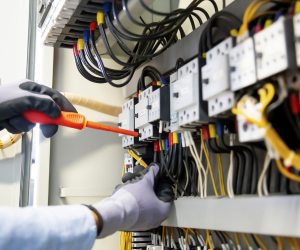Powering the Future: How Commercial Businesses Are Upgrading Their Electrical Systems for Efficiency, Safety, and Growth

In recent years, commercial businesses have increasingly recognized the importance of upgrading their electrical systems to enhance energy efficiency, ensure safety, and support modern technological demands. These upgrades not only reduce operational costs but also contribute to sustainability goals and improve property values.
Energy Efficiency and Cost Savings
One of the primary motivations for electrical upgrades is to achieve greater energy efficiency. Outdated electrical systems often consume more power, leading to higher utility bills. By transitioning to energy-efficient components, businesses can significantly reduce their electricity usage. For example, upgrading to LED lighting can decrease energy consumption by up to 75% compared to traditional incandescent bulbs. Additionally, implementing smart lighting systems with occupancy sensors and dimming capabilities further optimizes energy use, aligning with sustainability goals and potentially qualifying buildings for energy efficiency certifications.
Enhanced Safety and Compliance
Outdated electrical systems can pose serious safety risks, including fire hazards and electrical shocks. Electrical retrofitting addresses these concerns by bringing buildings up to current safety standards and codes. Modern circuit breakers, ground fault circuit interrupters (GFCIs), and arc fault circuit interrupters (AFCIs) provide advanced protection against electrical faults. Upgrading wiring and electrical panels improves the overall safety of the electrical distribution system, protecting occupants and assets while helping avoid costly fines and legal issues associated with code violations.
Improved Reliability and Performance
As businesses increasingly rely on technology, a reliable electrical infrastructure becomes essential. Upgrading electrical panels and distribution systems increases capacity to handle modern power demands, preventing overloading and reducing the likelihood of outages or equipment failures. Power quality improvements, such as installing surge protectors and power conditioning equipment, protect sensitive electronic devices from voltage fluctuations and other electrical disturbances. These upgrades result in fewer disruptions to business operations, increased equipment longevity, and improved overall productivity.
Flexibility for Future Technologies
Electrical retrofitting provides an opportunity to future-proof commercial buildings. By upgrading electrical systems with scalability in mind, building owners can more easily accommodate emerging technologies and changing tenant needs. Installing additional electrical capacity and data infrastructure supports the integration of smart building technologies like IoT devices and advanced building management systems. This flexibility allows buildings to adapt to evolving business requirements and technological advancements without frequent, disruptive upgrades.
Conclusion
Upgrading electrical systems in commercial buildings offers numerous benefits, including improved energy efficiency, enhanced safety, increased reliability, and long-term cost savings. By proactively investing in electrical upgrades, businesses can ensure compliance with regulations, support advanced technology, and boost property value, positioning themselves for long-term success in an increasingly competitive and technology-driven market.
